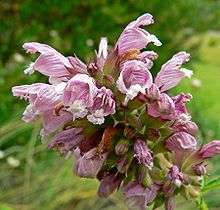Cedronella
| Cedronella canariensis | |
|---|---|
 | |
| Scientific classification | |
| Kingdom: | Plantae |
| (unranked): | Angiosperms |
| (unranked): | Eudicots |
| (unranked): | Asterids |
| Order: | Lamiales |
| Family: | Lamiaceae |
| Genus: | Cedronella Moench |
| Species: | C. canariensis |
| Binomial name | |
| Cedronella canariensis (L.) Webb & Berthel. | |
| Synonyms[1] | |
| |
Cedronella is a genus of flowering plants in the Mentheae tribe of family Lamiaceae, comprising a single species, Cedronella canariensis, native to the Canary Islands, the Azores, and Madeira. It is also naturalized in various places (South Africa, St. Helena, New Zealand, California).[2] Common names include Canary Islands-balm,[3] Canary balm, and Balm-of-Gilead.[4]
It is a perennial herbaceous plant growing to 1-1.5 m tall. The distinctive feature of these plants is the compound leaves consisting of 3 leaflets, unusual in the Lamiaceae, which usually have simple leaves. The leafy stems terminate in dense, short spikes of flowers with tubular 2-lipped white or pink flowers.
The genus name is a diminutive of Cedrus, though the only connection between this herb and the large conifers of Cedrus is a vaguely similar resinous scent of the foliage.
Cultivation
Grown outdoors in mild climates, these perennials need protection in a sunny position in the herb garden and moist, well-drained soil. In cool climates they can be grown in a sunny conservatory. Water freely in the growing season. Propagate from seed or from cuttings.
References
- ↑ "The Plant List".
- ↑ Kew World Checklist of Selected Plant Families
- ↑ USDA GRIN entry for Cedronella canariensis
- ↑ Bailey, L.H.; Bailey, E.Z.; the staff of the Liberty Hyde Bailey Hortorium (1976). Hortus third: A concise dictionary of plants cultivated in the United States and Canada. New York: Macmillan.
- David Bramwell and Zoë Bramwell. Wild Flowers of the Canary Islands. Editorial Rueda, Madrid, España. 2001. ISBN 84-7207-129-4
- J. R. Press and M. J. Short. Flora of Madeira. Natural History Museum, UK. 1994. ISBN 0-11-310017-5
External links
| Wikimedia Commons has media related to Cedronella canariensis. |
- Genera of Lamiaceae tribe Mentheae on www.ars-grin.gov